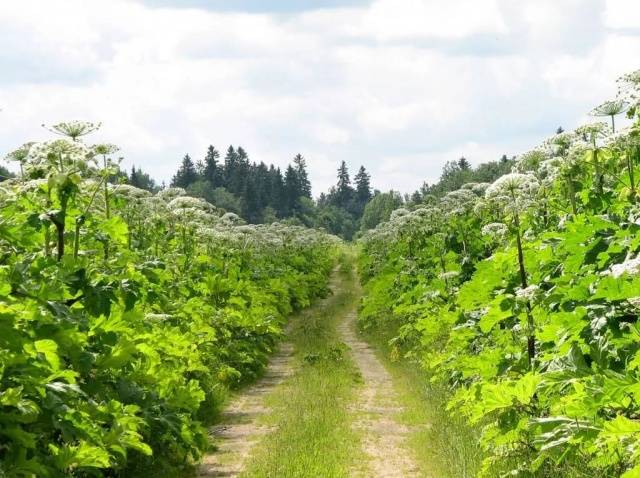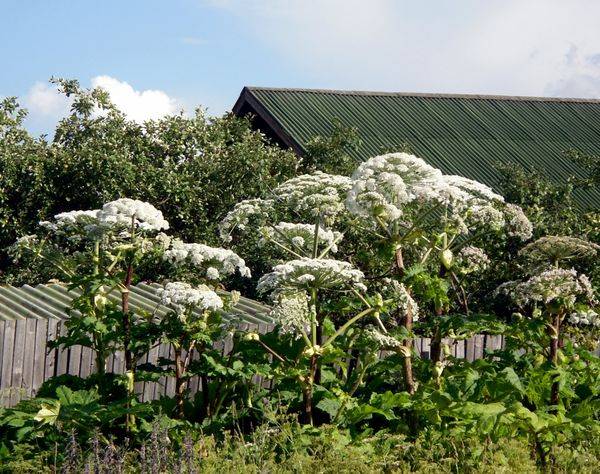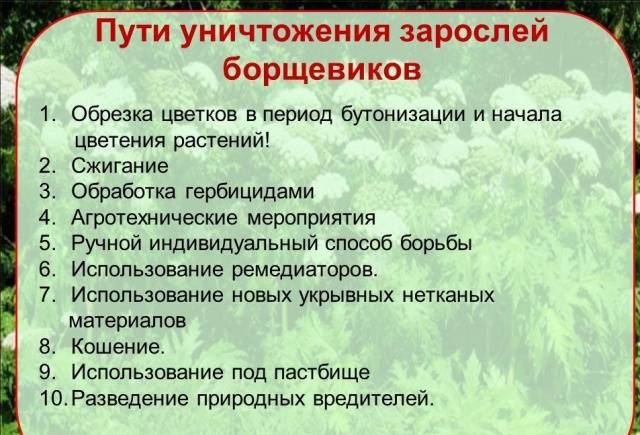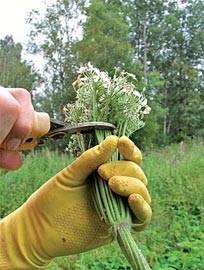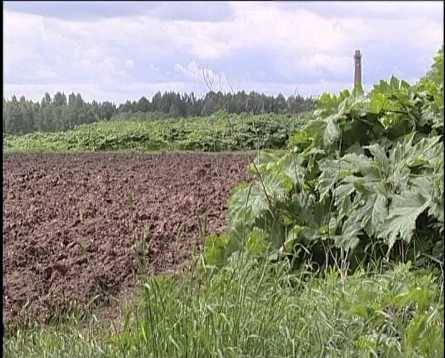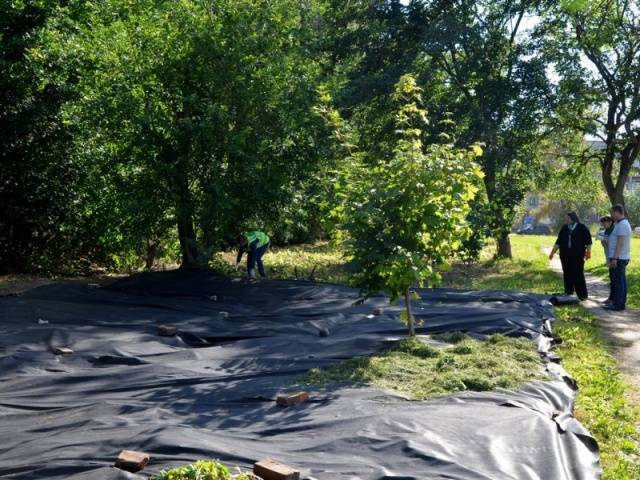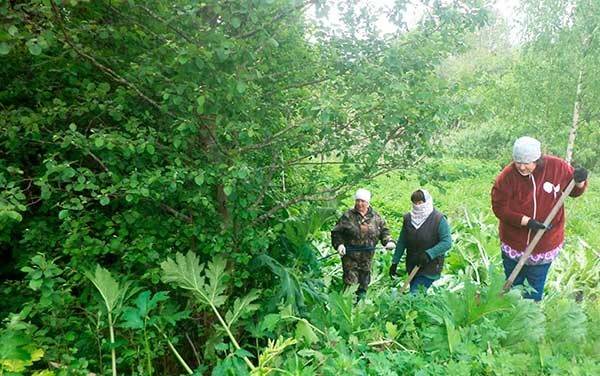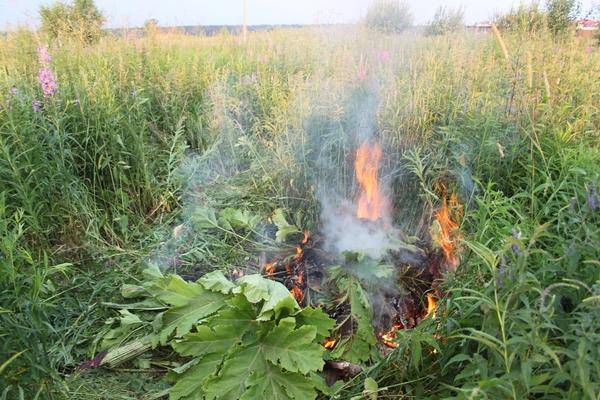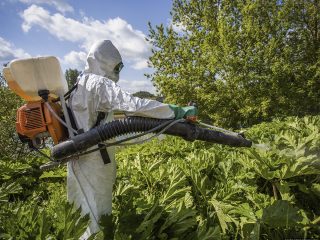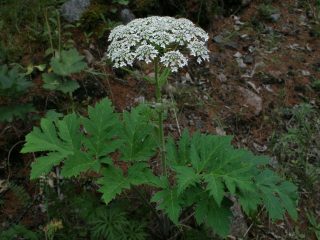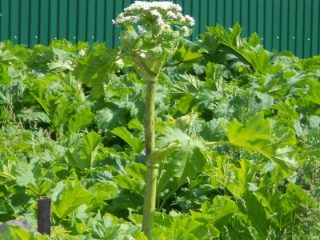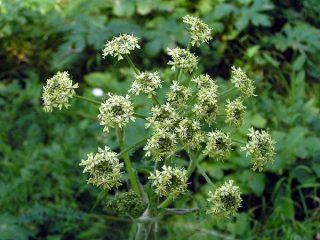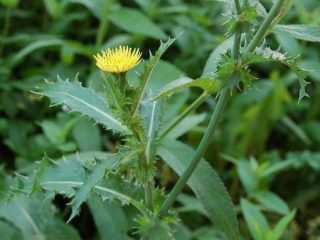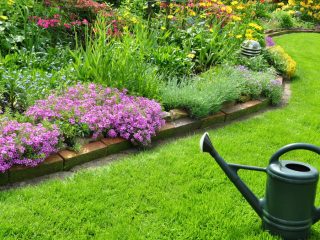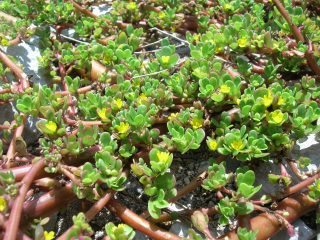Content
- 1 What is the danger of Sosnovsky's hogweed
- 2 The fight against hogweed at the government level
- 3 How to deal with hogweed
- 4 Application of remediators Comment! The expansion of hogweed plantations was facilitated by perestroika, when the area under crops was significantly reduced. Comment! The expansion of hogweed plantations was facilitated by perestroika, when the area under crops was significantly reduced. In areas where hogweed is being destroyed, it is possible to sow new plant species, scientifically called remediators. Such recommendations are given by the Timiryazev Academy. It is best to use fast-growing grains, for example, rump, or legumes. It’s a good idea to plant plowed lands with potatoes and Jerusalem artichokes. This contributes not only to the destruction of hogweed, but also to the restoration of farmland. In areas where hogweed is being destroyed, it is possible to sow new plant species, scientifically called remediators. Such recommendations are given by the Timiryazev Academy. It is best to use fast-growing grains, for example, rump, or legumes. It’s a good idea to plant plowed lands with potatoes and Jerusalem artichokes. This contributes not only to the destruction of hogweed, but also to the restoration of farmland. About the experiment to combat Sosnovsky's hogweed with the help of Jerusalem artichoke: About the experiment to combat Sosnovsky's hogweed with the help of Jerusalem artichoke: On the forums of gardeners and summer residents, it is proposed to plant raspberries in areas where hogweed inhabits. The root system of this plant is quite powerful, and according to the “testers”, it fights well against hogweed. On the forums of gardeners and summer residents, it is proposed to plant raspberries in areas where hogweed inhabits. The root system of this plant is quite powerful, and according to the “testers”, it fights well against hogweed. Methods of combating hogweed in the country: Methods of combating hogweed in the country: Attention! The more often the land is plowed and weeded, the less opportunity the dangerous pest will have to bloom and seed new areas. It is forbidden to mow the weed when the fruit is set. The seeds spill out and contaminate the soil even more. All cut material must be burned. The fact is that the stem has a huge supply of nutrients, the seeds have time to ripen and are scattered over long distances. It is forbidden to destroy hogweed without waterproof clothing. An ordinary cloth gets wet and the juice gets on the skin. It can last for several days. When exposed to sunlight, burns appear on the body. Let's summarize and what not to do
Sosnovsky's hogweed did not previously grow in many regions of Russia. After the Great Patriotic War, it was recommended for making silage for farm animals. But it soon became clear that this culture had a negative effect on the quality of milk and offspring. Sow hogweed stopped, but their proliferation by self-sowing seeds in the wild has since acquired alarming proportions.
If Sosnovsky's hogweed has spread outside the dacha area, then gardeners will soon have to come up with methods to get rid of this plant. How to deal with hogweed in the country will be discussed further. Summer residents often experiment, find all sorts of methods to combat it and discuss the results on forums.
What is the danger of Sosnovsky's hogweed
Sosnovsky's hogweed is a poisonous plant. It is easy to get burned from contact with it. If weed juice or pollen gets into your eyes during flowering, you can even go blind. Allergic and toxic effects weed per person is aggravated if you do not treat the burn site and stay in the open sun.
Today, this plant is occupying more and more space, turning into real forests. After all, the height of the weed can be more than three meters. The rapid spread of a harmful weed on a site or in a field makes it difficult to combat it. Today this scourge has acquired catastrophic proportions throughout the world. In many European countries, for example, Germany, France, Estonia, as well as Russia, programs have been created at the state level to combat hogweed in areas of its mass growth.
Ecological catastrophy:
The fight against hogweed at the government level
Sosnovsky's hogweed has long ceased to be an agricultural crop and has become a real scourge of farmland and summer cottages. While people abroad take the problem seriously, in Russia the government does not give the weed the status of a dangerous plant.
The fact is that in the Moscow region, Leningrad and other regions of Russia, funds are allocated to fight the weed, but the matter itself is not handled quite correctly. How to fight hogweed in a summer cottage if all powers to combat it are transferred to municipalities with poor budgets. This confrontation between the authorities will not lead to anything good; the weed will not “resolve” by itself.
Giant weeds are controlled selectively on public lands. But on private plots, agricultural producers are left with the problem of this harmful weed alone, fight it however you want. The worst thing is that in recent years Sosnovsky's hogweed has been conquering not only the areas around villages, but also getting into cities, populating wastelands and roadsides.
First of all, municipalities must draw up a program, take care of means of combating Sosnovsky's hogweed, and select a team of competent specialists. And the state should allocate funds for measures to combat it.
Scientists in the fight against the giant:
How to deal with hogweed
Sosnovsky's hogweed is a tenacious plant. It blooms once in its life, after which it dies. If conditions for reproduction are unfavorable, the weed may delay flowering until next year. Rhizomes can overwinter in the ground for several years. It turns out that it is not so easy to overcome the weed, because one plant can throw out several thousand dill-like seeds in one season.
Sosnovsky's hogweed is a tenacious plant. It blooms once in its life, after which it dies. If conditions for reproduction are unfavorable, the weed may delay flowering until next year. Rhizomes can overwinter in the ground for several years.It turns out that it is not so easy to overcome the weed, because one plant can throw out several thousand dill-like seeds in one season.
What methods of combating this malicious weed will you have to choose? This topic will never lose its relevance. On forums, gardeners and gardeners constantly discuss measures to combat the evil giant and offer their own time-tested options.
Let's look at the most common methods.
Trimming
The plant should be pruned when buds form and flowering begins. So, you can fight Sosnovsky's hogweed over large areas. When pruning, the umbrella with buds on the weed is removed.
The plant should be pruned when buds form and flowering begins. So, you can fight Sosnovsky's hogweed over large areas. When pruning, the umbrella with buds on the weed is removed.
If it was not possible to remove the weed buds in time and the flowering plants were simply mowed down, new umbrellas may appear from the root rosettes. They will also have to be removed, this is the only way to overcome the weed.
Burning
Plant seeds need to be burned before they have time to ripen. They are doused with a flammable mixture and set on fire. Despite the effectiveness of the fight against hogweed on the site, it is very dangerous. Not only can you accidentally douse yourself with a flammable product, but the seeds will also begin to release toxic essential oils.
Plant seeds need to be burned before they have time to ripen. They are doused with a flammable mixture and set on fire. Despite the effectiveness of the fight against hogweed on the site, it is very dangerous.Not only can you accidentally douse yourself with a flammable product, but the seeds will also begin to release toxic essential oils.
Chemical attack
To destroy Sosnovsky's hogweed, herbicides are used:
To destroy Sosnovsky's hogweed, herbicides are used:
- Roundup;
- Tornado;
- Groundup.
Important! Weeds must be treated frequently and intensively before the hogweed blooms. When the seeds are ripe, there will be no desired effect.
Important! Weeds must be treated frequently and intensively before the hogweed blooms. When the seeds are ripe, there will be no desired effect.
